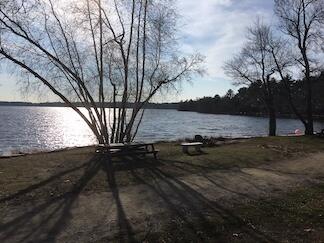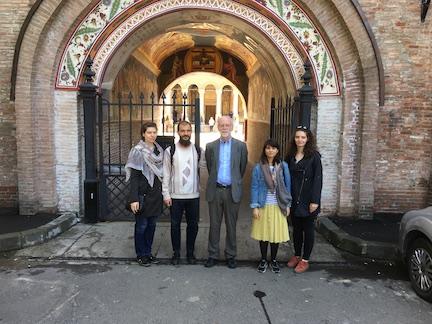Cambridge, MA. 
I have been back for a few days now, though not enough to be quite over jetlag, from a nearly two week trip first to the Catholic University in Leuven in Belgium for the dissertation defense of Fr. Dr. Yesudasan Remias, who wrote very well on the theme, "In Search of the Hidden God in Bhagavad-Gītā and Deutero-Isaiah," and at the end of the trip for several days of conversation and a lecture in beautiful Bucharest. In between, the main part of my trip was a visit to Hungary on the occasion of the Hungarian translation of my 2010 book, Comparative Theology (See the picture to the left) In relation to the book and beyond it, I gave about seven lectures, with the book’s very skilled translator, Professor Tibor Görföl, rendering my words in Hungarian. In Budapest, I lectured at the Theology Faculty at Pázmány Péter Catholic University and at the Jesuit Cultural Center and Dialogue Center (Párbeszéd Háza). A summary of that lecture can be found here. Mine was but one event on a very busy schedule at the Center, involving ideas, the arts and music, and all manner of topics related to religion today.
In southern Hungary, I gave my main lecture in Pécs at the University of Pécs, at the Centre for Internationalization and Connections. You can find some pictures and a summary in Hungarian here. Near the city I also met with a very smart and lively group of Carmelite Sisters for a two hour conversation of my work and their own views about interreligious learning (and they are quite open to it).
At the end of the week I visited the very ancient and beautiful Archabbey in Pannonhalma not far outside Budapest, and spoke with the students there. A bonus was a very pleasant two hours in conversation with the staff and community of Bhaktivedanta College.
 Thus the schedule. The context was of course contemporary Hungary, largely unknown to me before this trip. I remember from early childhood the Hungarian Revolution of 1956, and the long imprisonment of Cardinal Mindszenty. I knew also of Hungary’s recent resistance to the acceptance of refugees, and deep interreligious suspicions among the largely Catholic population. Since I was lecturing on Hinduism and my reception of it as a Catholic, I was told more than once about local suspicions about yoga — from the devil! — among some Catholics here. But I met no such people; those who came to my lectures were interested, full of challenging and pertinent questions.
Thus the schedule. The context was of course contemporary Hungary, largely unknown to me before this trip. I remember from early childhood the Hungarian Revolution of 1956, and the long imprisonment of Cardinal Mindszenty. I knew also of Hungary’s recent resistance to the acceptance of refugees, and deep interreligious suspicions among the largely Catholic population. Since I was lecturing on Hinduism and my reception of it as a Catholic, I was told more than once about local suspicions about yoga — from the devil! — among some Catholics here. But I met no such people; those who came to my lectures were interested, full of challenging and pertinent questions.
For both easy and difficult conversations, context matters: what are the local causes of fear, reasons for hope? who gains from the status quo, or from change? What is the history that shapes the current moment? Before coming I knew very little of Hungary’s difficult 1000 year history, which Wikipedia summarizes in a no-nonsense fashion:
The territory of modern Hungary was for centuries inhabited by a succession of peoples, including Celts, Romans, Germanic tribes, Huns, West Slavs and the Avars. The foundations of the Hungarian state were established in the late ninth century CE by the Hungarian grand prince Árpád following the conquest of the Carpathian Basin. His great-grandson Stephen I ascended the throne in 1000, converting his realm to a Christian kingdom. By the 12th century, Hungary became a regional power, reaching its cultural and political height in the 15th century. Following the Battle of Mohács in 1526, Hungary was partially occupied by the Ottoman Empire (1541–1699). It came under Habsburg rule at the turn of the 18th century, and later joined Austria to form the Austro–Hungarian Empire, a major European power. The Austro-Hungarian Empire collapsed after World War I, and the subsequent Treaty of Trianon established Hungary's current borders, resulting in the loss of 71% of its territory, 58% of its population, and 32% of ethnic Hungarians. Following the tumultuous interwar period, Hungary joined the Axis Powers in World War II, suffering significant damage and casualties. Hungary became a satellite state of the Soviet Union, which contributed to the establishment of a socialist republic spanning four decades (1949–1989). The country gained widespread international attention as a result of its 1956 revolution and the seminal opening of its previously-restricted border with Austria in 1989, which accelerated the collapse of the Eastern Bloc. On 23 October 1989, Hungary became a democratic parliamentary republic.
So much tumultuous history in a paragraph! Terrible ups and downs indeed, so many victims and so many perpetrators.
There is much to be said about the fate of small countries caught between East and West, subject to invasions over the centuries, and how that history affects people’s sense of themselves and others. For current writing on other dimensions of today's Hungary, see Franklin Foer's "Liberalism's Last Stand," in the June 2019 Atlantic, and the May 21 report in the New York Times on migrants in Hungary.
 But I myself was not in Hungary for political analysis, for which I am not qualified, and I resist the fancy that a week’s visit makes me entitled to assess a country’s politics with much insight. I had very specific conversation partners, and that privilege was more than enough for one week; I do understand interreligious dialogue and relationships, and I was invariably impressed with the intellectual interests and religious concerns of the Hungarians I met, day after day. I respected their evident concern to cultivate and nurture Hungarian culture and Hungary’s unique language and literary history, and also to envision and to defend a vital, 21st century Catholicism.
But I myself was not in Hungary for political analysis, for which I am not qualified, and I resist the fancy that a week’s visit makes me entitled to assess a country’s politics with much insight. I had very specific conversation partners, and that privilege was more than enough for one week; I do understand interreligious dialogue and relationships, and I was invariably impressed with the intellectual interests and religious concerns of the Hungarians I met, day after day. I respected their evident concern to cultivate and nurture Hungarian culture and Hungary’s unique language and literary history, and also to envision and to defend a vital, 21st century Catholicism.
My lectures, as mentioned, had to do with interreligious learning, and how I, a Jesuit (nearly 50 years), and a priest (nearly 41 years), have learned from Hinduism over the past 46 years. This was the real point of the trip in terms of what someone like me could offer in so brief a visit: to show in various ways, with an autobiographical touch, in various contexts (as in Romania too), how interreligious openness is an attitude with deep Catholic roots, and to the benefit of the Church itself, wherever it puts down roots. Fear of the religious other and polemic – this religious practice is from Satan, that one paves the way to relativism – can hardly be said to fit Catholicism at its best. I have a lot to learn about Eastern Europe, but I was encouraged to find that my experiences as an American Catholic priest who studies Hinduism resonated with listeners in today’s Hungary.
 My visit to Romania was a smaller affair, hosted by Dr. Valentin Cioveie and his students. I enjoyed walking around the center of Bucharest, visiting a number of Orthodox churches, one for Sunday worship, and most of all, intense conversations with my hosts, again on interreligious learning. Romania is mainly Orthodox, and I could see that my version of the Christian story as a Catholic one would not immediately win over believers committed to such a venerable and different kind of Christianity. But Dr. Cioveie and his students have hope for the future.
My visit to Romania was a smaller affair, hosted by Dr. Valentin Cioveie and his students. I enjoyed walking around the center of Bucharest, visiting a number of Orthodox churches, one for Sunday worship, and most of all, intense conversations with my hosts, again on interreligious learning. Romania is mainly Orthodox, and I could see that my version of the Christian story as a Catholic one would not immediately win over believers committed to such a venerable and different kind of Christianity. But Dr. Cioveie and his students have hope for the future.

